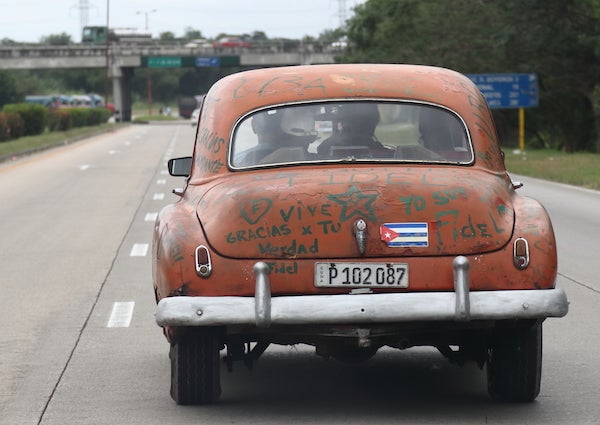This article was published in Scientific American’s former blog network and reflects the views of the author, not necessarily those of Scientific American
Something extraordinary happened at a satellite event during the annual meeting of the American Association for the Advancement of Science (AAAS) a few weeks ago. A special session on the alleged “sonic attack” on U.S. embassy personnel in Havana was organized by Mitchell Valdés-Sosa, co-director of the Cuban Neuroscience Center in Havana, together with Pedro Valdés-Sosa who co-chaired the session. Held at the Cuban embassy in Washington, the session brought together scientists from the United States and Cuba in a panel discussion to analyze the scientific evidence for the alleged clandestine weapon, which the U.S. State Department and a Journal of the American Medical Association article claim caused widespread traumatic brain injury to embassy staff serving in Havana.
The alarming report of an energy beam weapon of a kind unknown anywhere in the world before now has roiled through the press for nearly two years, generating world-wide alarm and fear. The incident has resulted in the U.S. essentially closing its embassy in Havana; curtailed travel by Americans to Cuba following warnings issued by the U.S. State Department; and a Senate hearing on the alarming “threat,” organized and chaired by the Cuban-American U.S. Senator Marco Rubio. All of this has compounded the suffering of Cubans and U.S. embassy staff.
My purpose here is not to recap the session or to sift through all the evidence. I’ve done that in previous articles and a video from the session is available on YouTube for anyone to watch and form their own opinions. Instead, I am driven to share a sudden realization that struck me as I was participating as one of the panelists in the session. This is something that has been overlooked while the world has intensely focused on the details of the frightening reports and tried to sleuth out the mind-boggling means and motive of the “attacks.”
On supporting science journalism
If you're enjoying this article, consider supporting our award-winning journalism by subscribing. By purchasing a subscription you are helping to ensure the future of impactful stories about the discoveries and ideas shaping our world today.

Credit: R. Douglas Fields
As a panelist I expressed my view, which I reached after traveling to Havana and carefully reviewing the evidence, that the “Cuban sonic weapon attack” is not about neuroweapons. Rather it is about the core values and mission of the AAAS: to promote scientific integrity and to communicate science accurately to the general public. I expressed my view that the media sensation that has swept through news outlets and major scientific journals for over two years, is fueled by a failure of journalism. The din of sensational coverage in the media overwhelms the accurate reporting by science writers. It was while I was making this argument on stage, that I suddenly realized what an extraordinary thing was transpiring.
Among the audience were reporters from major news and science news outlets. I admit trepidation in facing them while stating my criticism of those seated in the audience who carry out this difficult profession. I charged that journalists who had succumbed to sensationalism and ignored their responsibility of fact-based reporting bore much of the blame. They had failed to adhere to fundamental tenets of careful sourcing, verification, obtaining knowledgeable independent views and—to perform the most important role of journalism in a democracy— questioning government authority.
And then something occurred to me as I sat there inside the ornate gold-trimmed room inside the Cuban embassy. I looked out from the stage and caught the gaze of the Cuban ambassador, José Cabanas, seated in the front row, raptly listening to what the scientists had to say. While the discussion probing the physics of microwaves and sound propagation dimmed in my mind to background noise, an epiphany flashed. Here we were, scientists brought together in common purpose; half of them Communists and half capitalists believing in democracy, joined by journalists and science writers to seek truth through science and fact-based reporting.
Here, inside the embassy of a Communist nation forged in a revolution against capitalist exploitation, where production, education, and the press are managed by central control, the discussion had turned to the importance of a free and accurate press. All in the room had assembled to seek truth through science and reason; to defend against government exploitation of the press and to confront propaganda. We were all here, drawn by our shared human drive to seek truth; to help if someone is ill; to identify and bring to justice the perpetrator if someone is injured; and to achieve these most sacred human values through science and accurate reporting.
If political interests had fanned the Cuban sonic attack story in the press to divide the U.S. and Cuba, it had backfired.
I’ve seen the many “Viva la revolución!” slogans, and busts of Fidel Castro and Che Guevara, on my trips to Cuba. Right or wrong, those revolutionaries are a source of great pride for Cuban citizens. As I looked into the eyes of the Cuban ambassador, a sense of pride rose inside me as I thought of the revolutionaries of my own country, who were driven by the aspiration for freedom, and purpose to form a more perfect union.